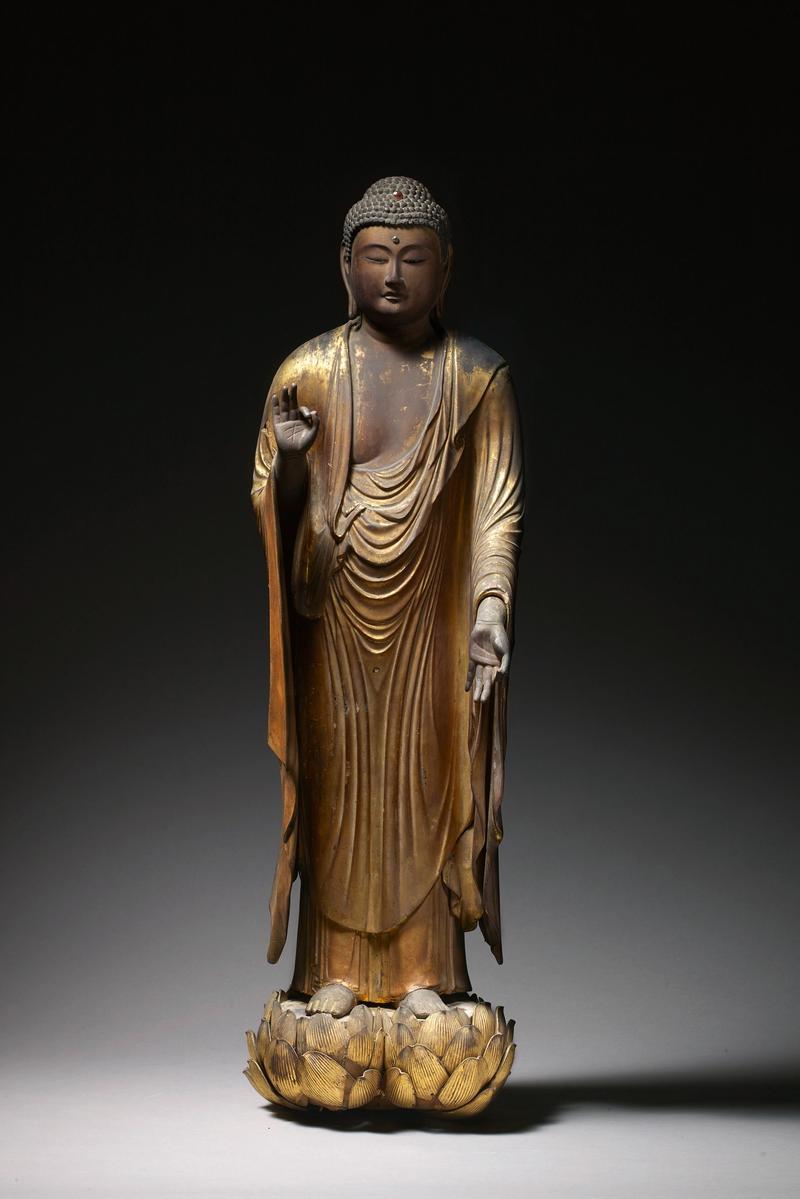A lacquered wood zushi (travelling shrine), containing a wood figure of a Jūichimen Kannon (Eleven-Headed Bodhisattva) seated on a lotus base, with a mandorla behind.
The left hand holds a byo (vase) and the right hand is in the yogan-in (the granting of wishes) mudra; the chest is bejewelled with a munakazari (pectoral ornament); the flowing robes are decorated in gold with vine and geometric designs.
The black-lacquered shrine has gilt metal mounts; its interior is gilded and painted with lotus flowers in water.
Japan, 17th/18th century, Edo period.
Kannon (Avalokiteśvara), the bodhisattva of mercy is one of the most widely worshipped Buddhist divinities in Japan. Kannon personifies compassion and is said to remain in this world to help mankind find salvation. The name Kannon, meaning 'watchful listening' is the shortened version of his original title, Kanzeon, meaning 'the one who constantly surveys the world and saves sentient beings upon hearing their sounds of suffering and cries for help'. The byo, containing the water or nectar of life, is a characteristic attribute of Kannon and seen here symbolises the nectar of his compassion.
Kannon manifests himself in many different forms, one of the oldest and most representative of these is Jūichimen Kannon (Sk: Ekadashamukha Avalokiteshvara), an esoteric form of the Bodhisattva who embodies the compassion of all Buddhas and became widely employed in tantric visualisations. In Japan, belief in the power of Jūichimen Kannon is recorded from Nara period (710-794).
According to a legend, Kannon vowed never to rest until he had freed all sentient beings from saṃsāra (process of birth and rebirth). Despite strenuous effort, he realised that still many unhappy and wicked beings were yet to be saved. After struggling to comprehend the needs of so many, his head split with grief into eleven pieces. Seeing his plight, Amida Buddha (Amitābha) transformed those 11 pieces into eleven heads with which to hear the cries of the suffering. He placed them on Kannon and topped them all with his own image.
The eleven small heads atop the Jūichimen Kannon symbolise his multifarious capacities in his merciful mission of saving sentient beings. They are also believed to dispel the eleven delusions, the fundamental causes of human agony, and guide people to the eleven virtues of Buddhahood, including enlightenment. The positioning of the heads indicates that the elevated head of the Buddha rises above the others – the iconography evokes the ten stages of the bodhisattva’s path towards enlightenment with the Buddha, from whom Kannon emanates, as the final result. The encapsulation of these processes into one image shows the presence of all within the bodhisattva and suggests the fully enlightened bodhisattva as the ideal.
Buddhist Art

A kakemono with the monk Hōnen

A kakebotoke

Zenkoji Kannon Bosatsu

A lacquer and gilt wood figure of a seated Amida Nyorai (Amitābha) dressed in a flowing robe

Buddhist wood panels

A wood figure of Amida Nyorai, Heian/Kamakura period

Amida Buddha

Jizō Bosatsu

Amida Buddha

A silk kakemono with Kannon

An iron nyoi

Zushi with Kannon

A bronze kakebotoke of Kannon













